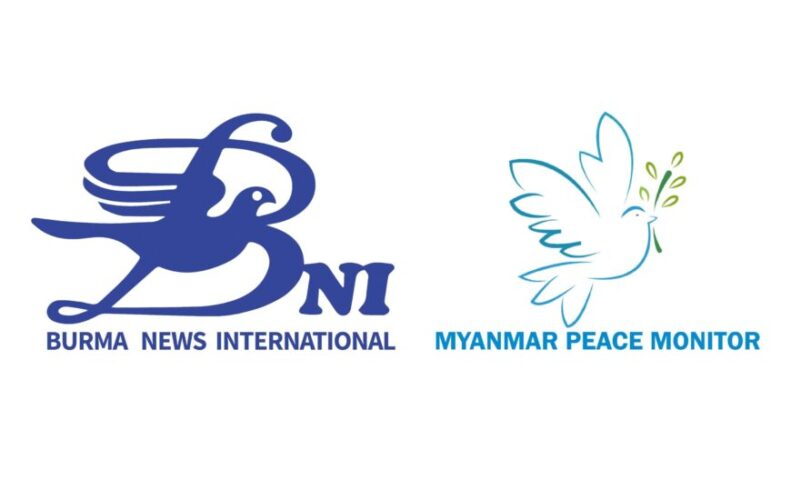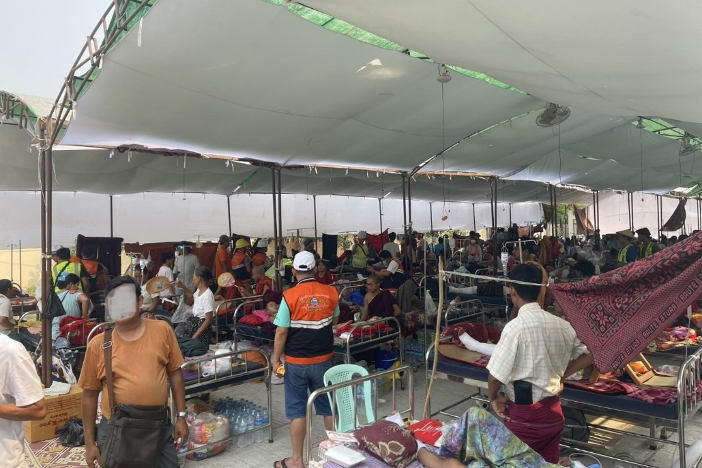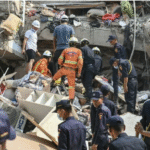An interview with a young member of the Shan Social Relief Association, about efforts to provide aid and support to Mandalay and Sagaing, regions severely impacted by the recent earthquake.
As of 9 April, a list compiled by the Democratic Voice of Burma (DVB) reports that the powerful 7.7-magnitude earthquake that struck near Sagaing on March 28 has claimed over 4,300 lives and caused extensive damage to homes and buildings in Mandalay, Tada-U, and Sagaing.
Rescue and relief teams have been actively working to support the hardest-hit areas of Mandalay and Sagaing. Among them are social relief organizations from Shan State, which have joined the ongoing efforts to provide aid and assistance.
Shan News interviewed a young Shan volunteer from a local social organization about the participation of Shan State-based groups in the ongoing relief operations.
Q: Could you share your experience traveling from Shan State to assist in the earthquake-affected areas of Mandalay and Sagaing? Additionally, which social or volunteer organizations from Shan State are currently participating in the relief efforts there?
A: In Shan State, NMBG is a strong social welfare association based in Nam Kham, and H.M.S. is another social assistance group from Muse. Both associations came down from Shan State to help. As Shan youth living in Mandalay, we’re here to support them in their efforts. At the Mandalay relief site, women’s groups like the Tan Yang Youth Group and the Panghsang Youth Group are also working alongside us, contributing not only their time but also donations and financial support.

Q: Please tell us about the current situation of the people, based on what you personally saw and experienced during the earthquake relief efforts.
A: We don’t have any data on the damage yet. We just went to help however we could—and we were able to support a lot of people. Right now, we’re moving around Sagaing, Tada-U, and Mandalay. In some areas, we go in as a team to assist homes, families, and communities that are in more urgent need. In Mandalay, families originally from Namkham reached out to the Namkham Social Association for assistance, especially those facing hardships after the earthquake. The Muse Social Association encountered similar situations. While there’s no exact data available, not all households from Namkham have asked for help—many well-off families haven’t contacted us. Some people are renting houses here; although their homes weren’t destroyed, nearby buildings collapsed and caused damage or harm. Thankfully, they’re doing okay for now. In Kywesekan, a girl is living alone in a rented house that she shares with five other families. Because Kywesekan is located on the outskirts, donors rarely come there. Our association visited after receiving information about the situation. There are many internally displaced persons (IDPs) from Shan State who have arrived in Mandalay. Some are staying with relatives, while others have taken shelter in monasteries. We’re doing our best to support those we can reach.
We also visited the Chinese temple in Amarapura, which was badly damaged by the earthquake. In Tada-U, we went through almost the entire area to assess needs. Additionally, we provided cash assistance—ranging from Ks 30,000 to Ks 50,000—to nearly all emergency patients in Mandalay General Hospital, 62nd Street Orthopedic Hospital, and Sagaing Hospital.
Q: What are some of the main challenges, difficulties and obstacles you’ve faced while providing aid and relief to the earthquake-affected areas?
A: We have a strong team, made up of both young and middle-aged people. The only real challenge we face is occasional fatigue in the evenings, but aside from that, there are no major obstacles. All our team members from Shan State came out to support us with incredible enthusiasm. People in Mandalay were also well-prepared, planning their trips and supplies in advance. They brought mosquito nets, mats, and rainproof sheets, transporting them separately by car. Our team members have divided responsibilities, with some carrying snacks, noodles, and cash to ensure everything is distributed efficiently.
The difficulty is similar to what we experienced during the flooding. Even people whose homes were not damaged, particularly in the squatter areas, are lining up to receive food parcels. Many are gathering to collect donations of food and money. However, we did not provide aid to households in the wards of Seinpan, Mandalay. As soon as we opened the back covers and side doors, people appeared out of nowhere and swarmed around us. Given the large number of people affected, careful organization and management were essential. As a result, the committee decided to provide blankets, mats, and other essential items to about 400 households. For the remaining households, monetary assistance was offered instead.
Q: What types of relief supplies are most urgently needed by the persons during the earthquake relief efforts?
A: The first few days were difficult for them, especially in terms of food, and the weather was extremely hot. However, after about a week, it started raining, and the sky became overcast. They still need essential items like rainproof sheets, mats, and mosquito nets. Thankfully, donors have been coming nearly every day with food. I believe some wards have received more food and water than they actually need. For the first two days, we donated food boxes with Shan rice and curry. After that, our focus shifted to rehabilitation efforts, so we provided rainproof sheets, mats, and mosquito nets. As for food, we donated non-perishable dried noodles and soft drinks.
Q: To what extent have you been able to reach and provide assistance to the towns and regions you have visited so far?
A: As far as I know, we reached almost all areas in Tada-U. However, this doesn’t mean we were able to visit every house. We did not provide donations to those whose houses were severely damaged or collapsed right in front of their homes, as opposed to those on the roadside. We distributed drinking water randomly to those whose houses weren’t damaged. For those with severely damaged homes, we provided waterproof sheets and mats. In Tada-U, one or two people were waiting in front of their homes, and we made donations in various wards. In Sagaing, it’s more challenging to distribute aid because the ward heads don’t have accurate data.
In Sagaing, we were able to provide assistance to about half of the people in need. In Mandalay, in cases where condos with a large number of missing people were involved, the roads were closed off as emergency zones. In some wards in Sagaing, where there were many casualties, there is a lingering stench. It’s still noticeable in the northeast of the pagoda, even two or three days after the quake. We didn’t reach the areas where the bodies were being recovered. Our main focus has been on donating food and money, and I don’t have much information about the other issues.
Q: How do you collaborate with international aid organizations and other local groups in providing relief?
A: Among the local organizations, we collaborated with Ko Welu Kyaw’s group, using one of their cars to travel to Tada-U. The Shan State Off-Road team was responsible for welcoming the Chinese rescue team that arrived from Muse at the border. Local residents were instrumental in assisting them. We had to travel from Shan State, along the Chinese border, to Mandalay Region to pick up the team. By the time we met at the border, it was already night, and there were no cars on the road. At the border gate, we had to engage in a lot of communication. Since the rescue team had come on short notice for emergency relief, some of the troops hadn’t received all the necessary information yet, so we had to explain the situation thoroughly to help them understand. Upon reaching Mandalay, they coordinated with the embassy, and a local police van was there to welcome us.
Q: It’s been two weeks since the earthquake. In terms of the infectious diseases that have followed, what types of diseases are emerging in the areas where you’ve provided aid, and what measures are being taken for medical treatment?
A: In that regard, the hospital also receives support from many donors, and I believe people will continue to rely on the hospital for medical care. In Sagaing and Tada-U, the people primarily depend on the people’s hospital. We’ve also been donating water, food, and other supplies to the hospital. I haven’t observed many cases of infectious diseases personally. While the news reports this as a major concern, in Tada-U and Sagaing, donors are arriving daily to support the rebuilding efforts.
We don’t go directly to the affected homes to donate medicine. In Tada-U, we donated medicine to the superintendent at the people’s hospital. We helped everyone affected by the earthquake with cash. As for medicine, the donations were handled similarly in Sagaing. If it rains, there is a risk of infectious diseases, and some of the buildings where the bodies have not yet been exhumed still have an unpleasant odor.”
Q: What difficulties are faced by the displaced people from Shan State who fled to Mandalay and were affected by the earthquake?
A: Many poor families are currently seeking shelter at monasteries. Some of them had already fled from conflict before the earthquake, and now they’re facing another crisis. They have gone to stay with relatives and friends, but many buildings have developed cracks and are no longer safe. As a result, they’ve taken refuge in monasteries that remained undamaged. Some monasteries are hosting large numbers of people, with populations reaching into the hundreds. For example, over 100 internally displaced persons (IDPs) are staying at the Seiktathukha Shan Monastery at the foot of Mandalay Hill. Some IDPs are afraid to stay in their homes after experiencing the earthquake. They feel it’s too dangerous and have sought shelter at the monasteries for safety.
Q: Would you like to anything to add about earthquake relief?
A: We are young people from Namkham, Muse, Tanyin, and Pansan. It has been over a week since we arrived to help in Mandalay, Sagaing, Tada-U, and we’ve also reached Palake. Everyone’s been helping out with love, kindness, and encouragement. It’s definitely tiring, but there’s also a real sense of joy—because we’re helping so many people. And everywhere we go, the people there are genuinely happy and grateful. In Tada-U, we went door-to-door making donations. The elderly men and women shared their feelings, saying, ‘There has been war in Shan State for so long, yet we’ve never had the chance to go there, and no one has ever come to help them.’ But now, when it’s our turn to suffer, people have traveled all the way from such difficult and dangerous places to assist us. Some households were so overwhelmed with gratitude that they cried—tears streaming down their faces. Since we began organizing our relief efforts, we’ve reached out to different communities, including Chinese communities, and in Sagaing, Muslim communities as well. We didn’t discriminate between Shan, Bamar, or anyone else. Instead, we prioritized areas that were most severely affected—places where houses had collapsed or buildings had been destroyed, focusing on those in greatest need. I have helped many people from all races and religions who are truly struggling.
Some people may think that, since we come from Shan State, we only help the Shan community. But that’s not how we operate. Muse and Namkham are home to many ethnic groups, and it’s the same here. We choose the most affected areas and help everyone, using the donations from the public. We also have plans to donate in Inle soon.
Q: Thank you for taking the time to speak with us.
Sent by Shan News


